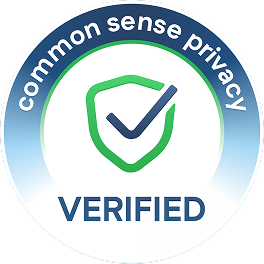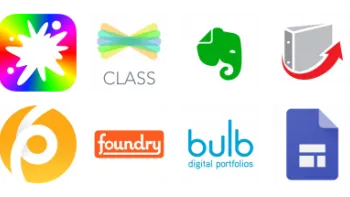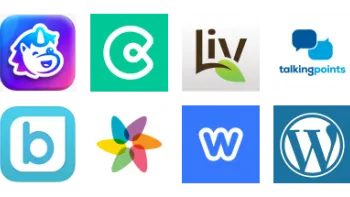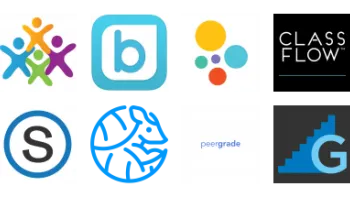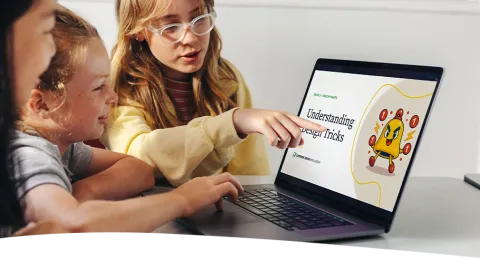
Digital Citizenship Week is October 20–24!
Join teachers worldwide to promote a healthy, positive approach to media and tech.
Take a look inside 10 images
ClassDojo
Pros: Free site offers ways to document, manage, and boost behavior, learning, and communication.
Cons: Behavior point system could prove problematic if used punitively or publicly.
Bottom Line: When used thoughtfully, ClassDojo can help adults support students' growth through goal-setting, reflection, and celebration.
ClassDojo is a tool that teachers can use in class from start to finish. Begin by displaying a welcome activity as students enter the room. Then, with a short Think-Pair-Share activity, use the timer and noise manager to keep the discussion on track and respectful. Next, assign an activity for student portfolios: Let kids draw out a challenging math problem, record a video discussing the novel they're reading, write a hypothesis for a science lab, or snap a picture of a completed assignment for teacher feedback. If you want to engage kids in critical thinking, consider assigning one or more Conundrum activities, and use them as a basis for class discussions on issues that do not have clear-cut answers. Throughout the class, award points to positively reinforce individuals or groups for meeting or exceeding expectations. Be careful to ensure that individuals aren't publicly singled out in negative ways: Consider privately using the app to track student behavior if you choose to use it at all. Close out the class with a five-minute growth mindset activity, giving kids a chance to wind down and reflect on their learning for the day.
Once or twice during the lesson, send a quick positive message or image to a child's parent or guardian. This is a great way to strengthen the school-to-home connection, celebrate classroom successes, and document student learning over time. Don't forget to add pictures to your Class Story to keep the grown-ups in the loop. Being able to see their children in action can help them feel like a part of their child's day. As with any parent communication platform, it's important to remember that it's possible some parents don't have easy access to tech and/or may not be super comfortable using tech, so find out what support parents might need to use the platform effectively.
ClassDojo is an online classroom management platform and app where teachers can record and track student behavior, facilitate classroom activities, curate student portfolios, and engage in school-to-home communication. Student sign-in is simple with a class code, QR code, or username. From the teacher dashboard, teachers can create original activities or use the toolkit to post class announcements, assign from the library, create random groups, and more. Depending on how they choose to set things up, teachers can share information privately or publicly, often displayed to the class on a screen or interactive whiteboard. It's possible to translate messages home into 30+ languages.
Along with points awarded or deducted for customizable positive and negative behaviors, teachers can assign activities to students to submit in the form of videos, audio, text, files, images, or drawings; once approved, these are documented in portfolios that follow students from year to year. Newer features include Conundrums, SEL-focused, short, hypothetical situations that students respond to via a response sheet. On the home-to-school side, parents or guardians can create accounts to see behavioral and academic progress as well as to message teachers. Teachers can also choose to share classroom events and photos, giving families a chance to feel more connected to the classroom. Families who wish to bring the ClassDojo features into their household can purchase a yearly subscription that allows them to set goals and award or deduct points for their kids for things that the parents choose, such as completing homework or doing chores.
Teachers may find that ClassDojo is a transformational tool in their efforts toward fostering stronger parent engagement. This type of real-time communication with students, groups, or the whole class can help make behavior and learning expectations more clear and concrete for students and families. And the ability to translate messages into more than 30 languages allows all parents to get involved and stay informed. Plus, teachers can assign activities to the whole class, groups, or individual students, which allows for differentiation.
It's important to note that the point system for behavior management could be problematic -- and even damaging -- depending on how a teacher uses it. Teachers should be sure to emphasize positive reinforcement and use the tool's public features in ways that support students' privacy and dignity. Even in light of teachers' best efforts, some students might still interpret the system in more of an extrinsic way. The program's effectiveness depends largely on responsible and consistent use. Thankfully, teachers don't have to display the point system or use it at all.
In terms of ClassDojo's learning management, communication, and SEL features, they can promote a wider picture of students' daily experiences and provide transparency for teachers, students, and families. While teacher feedback for student behavior is useful, these additional features allow stakeholders to see a larger picture of progress over time, perhaps enabling them to see the connections between student behavior and learning successes. In addition, the chance for students to demonstrate learning and receive meaningful feedback in nontraditional ways may help teachers to better evaluate a student's progress. Overall, the program can be a valuable way to keep instruction more whole-child focused, as a complement to a school's attention toward student academic skills and assessment.

















